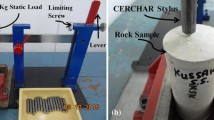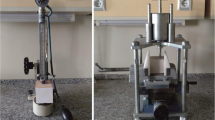Abstract
An important issue in any rock engineering project is the adequate prediction of tool consumption. Excavation tools are subjected to wear, and repair/replacement of those tools is usually an important expense on any excavation budget. The key factor that affects wear of excavation tools is rock abrasivity. In mining and civil engineering, rock abrasivity is typically measured by the Cerchar abrasivity index (CAI), which is obtained in laboratory from a Cerchar abrasivity test. This paper studied the relation between CAI and the chemical compounds and petrographical properties of andesitic rocks from the central area of Ecuador. A series of regression analyses are performed to study the influence of the different chemical compounds and petrographical properties on the CAI value. Results show that it is possible to make a good estimation of CAI from the plagioclase grain size and/or the content of SiO2, FeO, MgO, CaO, Na2O and K2O compounds.







Similar content being viewed by others
References
Al-Ameen SL, Waller MD (1994) The influence of rock strength and abrasive mineral content on the CERCHAR abrasive index. Eng Geol 36:293–301
Alber M (2007) Stress dependency of the Cerchar Abrasivity index (CAI) and its effects on wear of selected rock cutting tools. Tunn Undergr Space Technol 9:351–539
Alber M (2008) Stress dependency of the Cerchar abrasivity index (CAI) and its effects on wear of selected rock cutting tools. Tunn Undergr Space Technol 23:351–359
Alber M, Yaralı O, Dahl F, Bruland A, Käsling H, Michalakopoulos TN, Cardu M, Hagan P, Aydın H, Özarslan A (2014) ISRM suggested method for determining the abrasivity of rock by the CERCHAR abrasivity test. Rock Mech Rock Eng 47:261–266
ASTM D3967 (2001) Standard test method for splitting tensile strength of intact rock core specimens. American Society for Testing and Materials, West Conshohocken
ASTM D7012 (2010) Standard test method for compressive strength and elastic module of intact rock core specimens under varying states of stress and temperatures. American Society for Testing and Materials, West Conshohocken
ASTM D7625 (2010) Standard test method for laboratory determination of abrasiveness of rock using the CERCHAR method. American Society for Testing and Materials, West Conshohocken
Atkinson T, Cassapi VB, Singh RN (1986a) Assessment of abrasive wear resistance potential in rock excavation machinery. Int J Min Geol Eng 3:151–163
Atkinson T, Denby B, Cassapi VB (1986b) Problems associated with rock material properties in surface mining equipment selection. Trans Inst Min Metall Section A Miner Ind 95:A80–A86
Boland MP, Pilatasig LF, Ibandango CE, McCourt WJ, Aspden JA, Hughes RA, Beate B (2000) Geology of the western cordillera between 0°-1°N, mining development and environmental control project, map and geological information program, report no. 10, (Proyecto de Desarrollo Minero y control Ambiental, Programa de Informacion cartografica y Geológica, Informe no. 10), CODIGEM-BGS, Quito, Ecuador, p 72 (In Spanish)
CERCHAR (1986) The CERCHAR abrasiveness index. Centre d’Etudes et des Recherches des Charbonages de France, Verneuil, France
Deliormanlı A (2011) Cerchar abrasivitiy index (CAI) and its relation to strength and abrasion test methods for marble stones. Constr Build Mat 30:16–21
Deliormanlı AH (2012) Cerchar abrasivity index (CAI) and its relation to strength and abrasion test methods for marble stones. Constr Build Mater 30:16–21
Er S, Tugrul A (2016a) Correlation of physico-mechanical properties of granitic rocks with Cerchar Abrasivity index in Turkey. Measurement 91:114–123
Er S, Tugrul A (2016b) Estimation of Cerchar abrasivity index of granitic rocks in Turkey by geological properties using regression analysis. B Eng Geol Environ 75(3):1325–1339
Fowell RJ, Abu Bakar MZ (2007) A review of the Cerchar and LCPC rock abrasivity measurement methods. Proceeding of the 11th congress of the International Society for Rock Mechanics 155–160
Hamzaban MT, Memarian H, Rostami J (2014a) Continuous monitoring of pin tip wear and penetration into rock surface using a new Cerchar abrasivity testing device. Rock Mech Rock Eng 47(2):689–701
Hamzaban MT, Memarian H, Rostami J, Ghasemi-Monfared H (2014b) Study of rock-pin interaction in Cerchar abrasivity test. Int J Rock Mech Min Sci 72:100–108
ISRM (2007) The complete ISRM suggested methods for rock characterization, testing and monitoring: 1974–2006. International Society for Rock Mechanics, Lisbon
Kahraman S, Alber M, Fener M, Gunaydin O (2010) The usability of Cerchar abrasivity index for the prediction of UCS and E of Misis fault breccia: regression and artificial neural networks analysis. Expert Syst Appl 37:8750–8756
Käsling H, Thuro K (2010) Determining abrasivity of rock in the laboratory. European Rock Mechanics Symposium. EUROCK 2010, Laussane, Switzerland
Lassnig K, Latal C, Klima K (2008) Impact of grain size on the Cerchar abrasiveness test. Ernst and Sohn Verlag für Architektur und technische Wissenschaften GmbH and Co. KG. Berlin Geomechanik und Tunnelbau 1, Heft 1
Majeed Y, Abu Bakar MZ (2016) Statistical evaluation of CERCHAR Abrasivity index (CAI) measurement methods and dependence on petrographic and mechanical properties of selected rocks of Pakistan. Bull Eng Geol Environ 75:1341–1360
Michalakopoulos TN, Anagnostou VG, Bassanou ME, Panagiotou GN (2005) The influence of steel styli hardness on the Cerchar abrasiveness index value. Inter J Rock Mech Mining Sci Geomechan Abstracts 43:321–327
Moradizadeh M, Ghafoori M, Lashkaripour GR, Tarigh Azali S (2013) Utilizing geological properties for predicting cerchar abrasiveness index (CAI) in sandstones. Int J Emerg Technol Advan Eng 3(9):99–109
NF P 94–430-1 (2000) Determination du pouvoir abrasif d’une roche— Partie 1: Essai de rayure avec une pointe. Association française de Normalisation (AFNOR), Paris
Plinninger R, Kasling H, Thuro K, Spaun G (2003) Testing conditions and geomechanical properties in influencing the CERCHAR abrasiveness index (CAI) value. J Rock Mech Mining Sci 40:159–263
Rostami J, Ghasemi A, Gharahbagh AE, Dogruoz C, Dahl F (2014) Study of dominant factors affecting cerchar abrasivity index. Mech Rock Eng 47:1905–1919
StatPoint Technologies, Inc (2009) STATGRAPHICS centurion XVI user manual. StatPoint Technologies Inc, The Plains
Suana M, Peters T (1982) The CERCHAR abrasivity index and its relation to rock mineralogy and petrography. Rock Mech Rock Eng 15:1–7
Thuro K (1997) Prediction of drillability in hard rock tunneling by drilling and blasting. In: Golser, Hinkel and Schubert (Eds.) Tunnels for people, Balkema, Rotterdam, pp 103–108
Vallejo C (2007) Evolution of the western cordillera in the Andes of Ecuador (late cretaceous–Paleogene). Dissertation, Institute of Geology, ETH Zürich
Vallejo C, Winkler W, Spikings RA, Luzieux L, Heller F, Bussy F (2009) Mode and timing of terrane accretion in the forearc of the Andes in Ecuador. In: Kay SM, Ramos VA, Dickinson WR (Eds.) Backbone of the Americas: shallow subduction, plateau uplift, and ridge and terrane collision. Geol Soc Am Mem 204:197–216
Vera RH (2016) Geology of Ecuador. Iberia, Quito
Vezzoli L, Apuani T, Corazzato C, Uttini A (2017) Geological and geotechnical characterization of the debris avalanche and pyroclastic deposits of Cotopaxi volcano (Ecuador). A contribute to instability-related hazard studies. J Volcanol Geotherm Res 332:51–70
West G (1989) Rock abrasiveness testing for tunneling. Int J Rock Mech Min Sci Geomech Abstr 26:151–160
Yarali O, Yasar E, Bacak G, Ranjith PG (2008) A study of rock abrasivity and tool wear in coal measures rocks. Int J Coal Geol 74:53–66
Acknowledgements
This research did not receive any specific grant from funding agencies in the public, commercial, or not-for-profit sectors.
Author information
Authors and Affiliations
Corresponding author
Electronic supplementary material
ESM 1
(KML 1 kb)
Rights and permissions
About this article
Cite this article
Torrijo, F.J., Garzón-Roca, J., Company, J. et al. Estimation of Cerchar abrasivity index of andesitic rocks in Ecuador from chemical compounds and petrographical properties using regression analyses. Bull Eng Geol Environ 78, 2331–2344 (2019). https://doi.org/10.1007/s10064-018-1306-6
Received:
Accepted:
Published:
Issue Date:
DOI: https://doi.org/10.1007/s10064-018-1306-6




